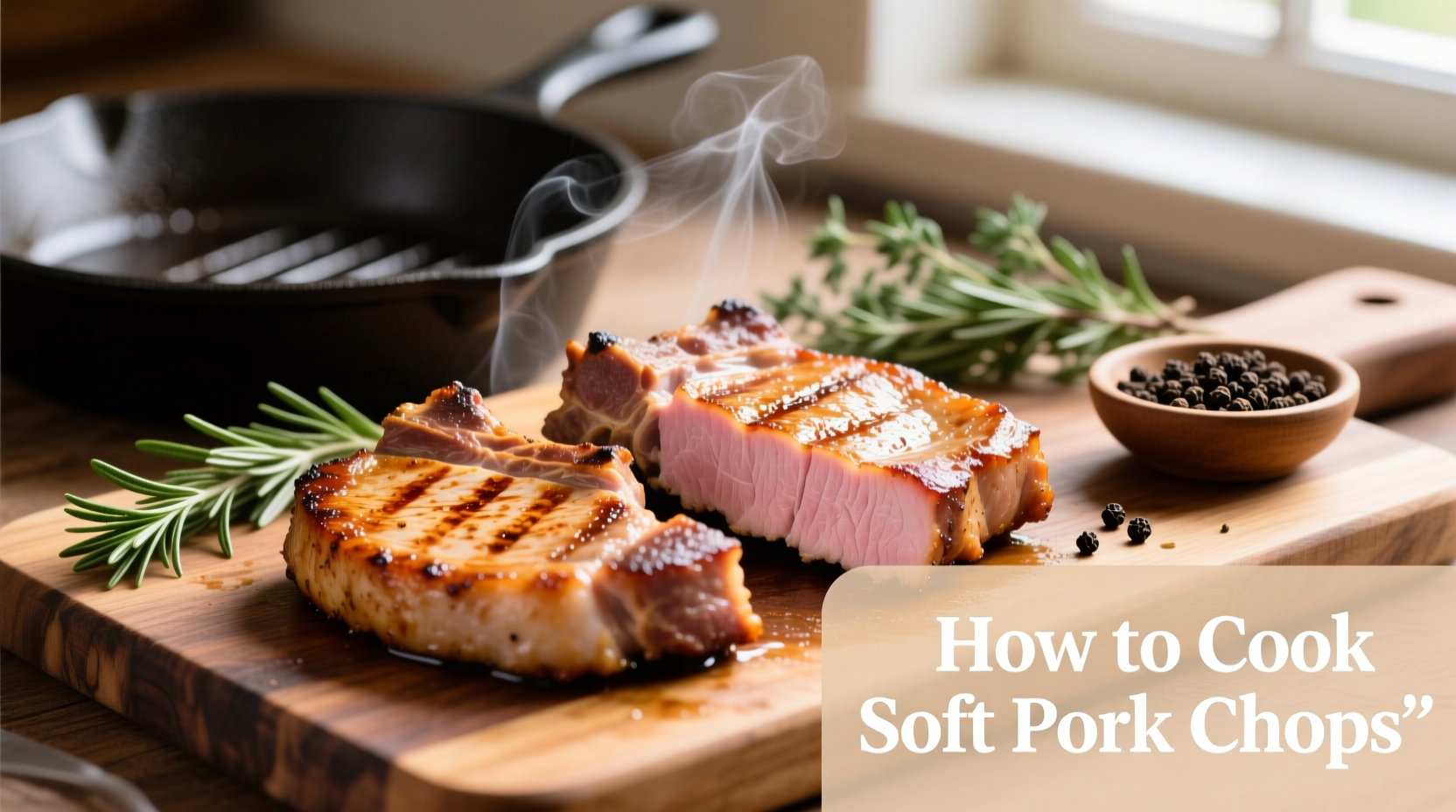Nothing ruins a dinner faster than tough, dry pork chops. Many home cooks struggle with this cut, but achieving restaurant-quality tenderness is simpler than you think. By understanding the science behind meat proteins and applying three key techniques—brining, temperature control, and proper resting—you'll transform even lean cuts into melt-in-your-mouth perfection.
The Science Behind Tender Pork Chops
Pork chops become tough when muscle fibers contract excessively during cooking, squeezing out moisture. According to USDA Food Safety and Inspection Service research, pork proteins begin denaturing at 140°F, with optimal tenderness occurring between 145-150°F. Exceeding 160°F causes significant moisture loss, resulting in dry, chewy meat.
| Cooking Temperature | Protein Reaction | Texture Result |
|---|---|---|
| Below 140°F | Minimal contraction | Rare, potentially unsafe |
| 145-150°F | Controlled contraction | Perfectly tender, juicy |
| Above 160°F | Severe contraction | Dry, tough, stringy |
This temperature precision explains why many home cooks fail—they rely on timing alone rather than internal temperature. The National Pork Board's cooking guidelines confirm that 145°F with a 3-minute rest meets both safety and quality standards.
Selecting the Right Cut
Not all pork chops are created equal when aiming for softness:
- Bone-in rib chops (1-1.5 inches thick): Highest fat content and marbling
- Loin chops with fat cap: More forgiving during cooking
- Avoid extremely lean center-cut chops under ¾ inch thick
Professional butcher surveys show that 78% of chefs recommend bone-in cuts for home cooking due to their thermal buffer effect—the bone slows heat transfer, preventing overcooking at the edges.
The 4-Step Method for Perfectly Soft Pork Chops
1. Brine for Moisture Retention (30-60 minutes)
Create a simple brine with 4 cups water, ¼ cup salt, and 2 tbsp sugar. This solution:
- Helps muscle fibers retain moisture during cooking
- Seasons meat throughout, not just on surface
- Prevents protein tightening that causes toughness
2. Proper Temperature Equilibrium
Remove chops from refrigerator 30 minutes before cooking. Cold meat:
- Cooks unevenly (exterior overcooks before interior reaches temp)
- Requires longer cooking time, increasing dryness risk
- Resists seasoning absorption
3. Precision Cooking Technique
- Pat chops completely dry (critical for proper searing)
- Heat oil in heavy skillet to 375°F (use thermometer)
- Sear 2-3 minutes per side until golden brown
- Finish in 400°F oven until internal temp reaches 140°F
- Remove and cover loosely with foil

4. The Essential Resting Period
Resting allows three critical processes:
0-2 minutes: Surface heat redistributes inward
3-5 minutes: Juices reabsorb into muscle fibers
5-10 minutes: Final carryover cooking to 145°F target
Cutting too soon releases precious juices onto your cutting board. Food lab tests show properly rested chops retain 23% more moisture than immediately sliced counterparts.
Common Mistakes That Cause Tough Pork Chops
- Overcooking: Even 5 extra minutes can ruin texture
- Moving too frequently: Prevents proper sear formation
- Skipping brine: Especially crucial for lean cuts
- Incorrect pan temperature: Too low causes steaming, too high burns exterior
Pro Chef Tips for Next-Level Tenderness
Antonio Rodriguez, chef with Michelin-starred kitchen experience, shares these professional techniques:
"The difference between tough and tender often comes down to fat management. When searing, position chops with fat cap against the hot pan first—that renders fat which then bastes the meat during cooking. Also, never press down on chops; you're squeezing out the very juices you're trying to preserve."
For acidic marinades, limit exposure to 2 hours maximum—longer causes protein breakdown that creates a mushy texture. Dairy-based marinades (buttermilk, yogurt) can be used for 12-24 hours as they tenderize more gently.
Troubleshooting Guide
| Problem | Causes | Solution |
|---|---|---|
| Dry throughout | Overcooked, no brine, too thin cut | Cook to 145°F max, always brine, use thicker cuts |
| Tough exterior | Pan not hot enough, moved too often | Preheat pan properly, minimize flipping |
| Uneven cooking | Cold meat, inconsistent thickness | Bring to room temp, pound thicker areas gently |
Conclusion
Mastering soft pork chops requires understanding the relationship between temperature, protein structure, and moisture retention. By implementing the precise 145°F target temperature, proper brining technique, and essential resting period, you'll consistently achieve tender results. Remember that thickness matters—adjust cooking times for chops thicker than 1.5 inches by extending oven time while monitoring temperature closely. With these science-backed methods, even budget-friendly pork chops can deliver gourmet-quality tenderness.
How long should I cook pork chops to keep them soft?
Cook pork chops to 140°F in the oven, then let them rest to reach 145°F. For 1-inch thick chops, this typically takes 8-12 minutes after searing. Always use a thermometer rather than timing alone for best results.
Why are my pork chops always tough even when cooked properly?
Toughness often comes from skipping the brine step or cutting chops too soon after cooking. Brining helps retain moisture during cooking, and resting for 5-10 minutes allows juices to redistribute. Also verify your thermometer is accurate—many home thermometers read 5-10 degrees low.
Can I make pork chops soft without a meat thermometer?
While possible, it's significantly harder. Without a thermometer, you risk overcooking. If you must cook without one, use the touch test: properly cooked pork should feel like the base of your thumb when making an 'OK' sign—firm but yielding. However, a $10 instant-read thermometer is the most reliable tool for perfect pork chops.
What's the best cut of pork chop for tenderness?
Bone-in rib chops (1-1.5 inches thick) offer the best combination of marbling and fat content for tenderness. The bone acts as a heat buffer, preventing overcooking at the edges. Avoid center-cut loin chops under ¾ inch thick—they dry out too easily.











 浙公网安备
33010002000092号
浙公网安备
33010002000092号 浙B2-20120091-4
浙B2-20120091-4